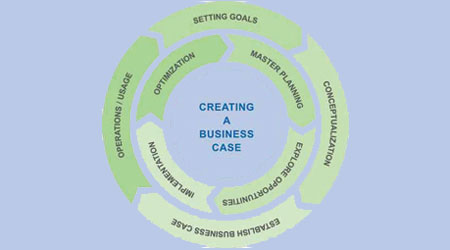Three Buckets of Smart Buildings Goals: Economic, Environmental, Experiential
Part 2 of a 2-part story on how data, BAS, and master planning all combine to create smart buildings.
Goals and outcomes generally can be categorized in three buckets: economic, environmental, and experiential. Economic outcomes include reduced operating and maintenance costs, lower construction costs, increased asset value, competitive advantage, tenant demand, and overall ROI. Environmental goals include energy reduction and optimization, sustainability, and corporate stewardship. Experiential outcomes include greater occupant satisfaction and comfort, increased productivity, occupant awareness and control, safety/security, and corporate pride.
Understanding the possibilities, modeling potential outcomes, and analyzing cost/benefits are essential in the conceptualization phase to establish the business case and strategy.
Facility managers have to understand the possibilities and to envision what opportunities their building/portfolio presents. By first understanding the possibilities, it is usually easier to define and better articulate outcomes the organization desires, such as to increase operational efficiency, reduce energy consumption, and improve occupant satisfaction.
When considering the possibilities and opportunities, it is important to have a clear understanding of the capabilities, configuration, and limitations of core building systems, ranging from building automation to power monitoring, vertical transportation, lighting control, plumbing and irrigation, fire/life safety, security, AV and digital signage, and network and communications.
While all of these systems and subsystems can be independently smart, they’re not “intelligent” alone. Each system usually continuously collects specific data that is monitored and controlled by unique software within the system silo. The ability of these systems to share data provides the opportunity to better optimize individual as well as overall building performance.
For example, visualization tools converge information from multiple systems — information that, through analytics, can be presented in different ways specific to the needs and desires of both the facility manager and the occupier as well as other stakeholders. Dashboards customized for each stakeholder can significantly increase efficiency and productivity. Occupant awareness and control, through mobility and visualization, has been proven to drive behavioral change, direct positive bottom line benefits, and increase overall experiential satisfaction.
Another opportunity is building-wide unified communications utilizing platform-converged digital antennae systems. These support ubiquitous and seamless network connectivity, interactive media mobility, and BYOD (bring-your-own-device) strategies.
Digital Credentialing
A third opportunity, mobile-based digital credentialing, will provide new levels of security, access control, and personal safety and well-being. Credentialing capabilities will continue to mature and evolve with the ability to improve efficiency through traffic management, directional parking, vertical destination dispatch, digital way finding, and workplace utilization management.
Once the possibilities have been understood, it is important to prioritize what is practical and appropriate. For existing buildings, facility managers should consider and balance what options provide the greatest near- and long-term ROI, and make decisions based on the established goals.
Forward future-fit strategies usually begin with an initial investment in a building-wide intelligent building network that will support the integration and convergence on an open-source non-proprietary platform. From this, the “low-hanging fruit” systems — such as the BAS, lighting control, and power monitoring — can be integrated and demonstrate immediate ROI. The ROI payback for this approach can be demonstrated and guaranteed by qualified intelligent building consultants.
After initial implementation, the intelligent-building journey can continue with the addition of enhanced analytics, fault detection and diagnostics, and the integration of occupant experiential and efficiency systems. Leveraging the ROI of energy-based systems to support the business case for future investments helps to achieve the master-planned intelligent building vision.
Early adapters are embarking on a journey to incorporate smart building systems seeking economic performance, sustainability, and occupant experience outcomes. This is equivalent to incremental change driven by simplistic short-term returns. Crossing the chasm into a truly intelligent built environment will require a roadmap, and facility managers should consider engaging an agnostic intelligent building consultant to develop plans aligned with a building occupant’s experience.
The future of intelligent buildings is experiential — and facility managers who embrace the intelligent building roadmap process will gain a competitive advantage.
Kurt Karnatz is president of Environmental Systems Design, Inc., Chicago.
Email comments and questions to edward.sullivan@tradepress.com.
Related Topics:










